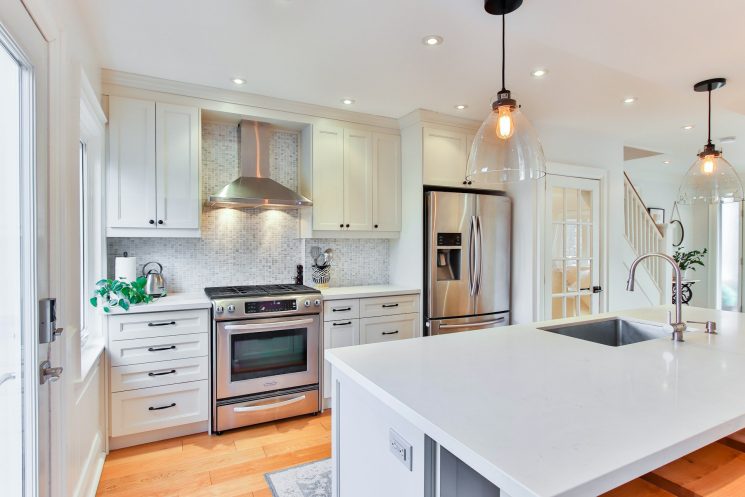Are you tired of working in a poorly-lit kitchen? You don’t have to settle for dull lighting anymore. In this article, we shine a light on kitchen illumination and help you determine the perfect number of downlights to transform your culinary space.
Proper kitchen lighting is not only essential for functionality but also for creating a welcoming ambiance. With the right amount of downlights, you can illuminate your work surfaces, enhance the style of your kitchen, and make every cooking experience a joy.
But how many kitchen downlights do you really need? Well, it depends on various factors such as the size of your kitchen, the height of your ceiling, and the overall lighting design you’re aiming for. We’ll guide you through these considerations and provide practical tips to help you find the perfect balance of lighting for your kitchen.
No more guesswork or dim corners – this article will equip you with the knowledge to make informed decisions about your kitchen lighting. Get ready to brighten up your cooking space and create a warm, inviting atmosphere that will inspire your culinary adventures. Let’s bring out the best in your kitchen with the perfect number of downlights.
Importance of Proper Kitchen Illumination
A well-illuminated kitchen is crucial for several reasons. Firstly, it ensures that you can see what you’re doing when preparing meals, preventing accidents and making your cooking process more efficient. Secondly, proper lighting can enhance the overall aesthetic of your kitchen, making it a visually appealing space. Lastly, the right lighting can create a warm and inviting atmosphere, turning your kitchen into a gathering place for family and friends.
When it comes to kitchen lighting ,downlights are a popular choice. These recessed lights are installed in the ceiling and provide a focused beam of light that can be directed towards specific areas. They offer a sleek and modern look, and their adjustable nature allows for flexibility in lighting design.
Understanding Downlights
Before we delve into determining the number of downlights needed for your kitchen, it’s important to understand how they work. Downlights consist of three main components: the housing, trim, and bulb. The housing is the part that is installed in the ceiling and holds the other components. The trim is the visible part of the downlight and comes in various styles to match your kitchen’s aesthetic. Lastly, the bulb is the light source and can be chosen based on factors such as brightness and colour temperature.
Downlights are typically installed in a grid pattern to evenly distribute light throughout the space. The spacing between each downlight will depend on the size of your kitchen and the level of illumination you desire. By strategically placing downlights, you can eliminate dark corners and shadows, ensuring that every part of your kitchen is well-lit.
Factors to Consider When Determining the Number of Downlights
When determining the number of downlights needed for your kitchen, several factors come into play. Consider the following:
Kitchen Size
The size of your kitchen is one of the most important factors to consider. Larger kitchens will require more downlights to provide adequate illumination. Smaller kitchens, on the other hand, may not need as many downlights. As a general rule of thumb, aim for one downlight per 4 to 6 square feet of kitchen space.
Ceiling Height
The height of your ceiling also affects the number of downlights needed. Higher ceilings may require more downlights to ensure sufficient lighting reaches your work surfaces. If your ceiling is higher than average, you may need to consult a professional to determine the appropriate number of downlights based on your specific ceiling height.
Lighting Design
The overall lighting design you have in mind for your kitchen will also impact the number of downlights needed. If you want a brighter and more evenly lit space, you may opt for a higher number of downlights. However, if you prefer a softer and more ambient lighting effect, you may choose to have fewer downlights and supplement with other types of lighting fixtures such as pendant lights or under-cabinet lighting.
Calculating the Number of Downlights Based on Kitchen Size
To determine the number of downlights needed for your kitchen, you can use a simple calculation based on the size of your space. Start by measuring the length and width of your kitchen in feet. Multiply these two values together to calculate the total square footage.
For example, if your kitchen is 15 feet long and 12 feet wide, the total square footage would be 180 square feet (15 ft x 12 ft = 180 sq ft).
Next, divide the total square footage by the recommended square footage per downlight. As mentioned earlier, a general guideline is one downlight per 4 to 6 square feet of kitchen space. Let’s assume we use the higher end of this range and aim for one downlight per 6 square feet.
Using the example above, divide 180 square feet by 6 to get the total number of downlights needed. In this case, you would require approximately 30 downlights (180 sq ft / 6 sq ft = 30 downlights).
Keep in mind that this calculation provides a rough estimate and should be adjusted based on other factors such as ceiling height and lighting design preferences.
Positioning and Spacing of Downlights
Once you have determined the number of downlights needed for your kitchen, it’s crucial to consider their positioning and spacing. Proper placement and spacing will ensure even illumination throughout the space.
A common approach is to install the downlights in a grid pattern, with each downlight positioned equidistant from its neighbouring lights. This creates a uniform distribution of light and minimises the appearance of shadows.
For example, if you have determined that you need 30 downlights for your kitchen, you can arrange them in a grid with 5 downlights per row and 6 downlights per column. This will provide a balanced lighting effect.
The spacing between each downlight will depend on the size of your kitchen and the level of illumination desired. As a general guideline, aim for a spacing of approximately 4 to 6 feet between each downlight. This will help prevent any dark or over lit areas.
Choosing the Right Wattage for Downlights
When selecting the bulbs for your downlights, it’s important to consider the wattage. The wattage determines the brightness of the light emitted. Choosing the right wattage will ensure that your kitchen is adequately illuminated without being too harsh or too dim.
The wattage needed will depend on the size of your kitchen and the level of brightness you desire. As a general rule, aim for 20 to 30 watts per square meter of kitchen space. This will provide a good balance between functionality and ambiance.
It’s worth noting that LED downlights are a popular choice for downlights due to their energy efficiency and longevity. They consume less energy compared to traditional incandescent bulbs and have a longer lifespan, reducing the need for frequent bulb replacements.
Different Types of Downlights for Kitchen Illumination
When it comes to downlights, there are various types to choose from, each offering different features and benefits. Here are a few popular options for kitchen illumination:
Fixed Downlights
Fixed downlights are the most common type and provide a fixed beam of light in a specific direction. They are suitable for general lighting purposes and are often used in kitchens to provide overall illumination.
Adjustable Downlights
As the name suggests, adjustable downlights allow you to adjust the direction of the light beam. This feature is particularly useful in the kitchen, where you may want to focus the light on specific areas such as countertops or the sink.
Dimmable Downlights
Dimmable downlights give you control over the brightness level of your kitchen lighting. This versatility allows you to adjust the ambiance of your kitchen based on different activities or moods.
IP-Rated Downlights
In areas where moisture is present, such as above the sink or near the stove, it’s important to choose downlights with an IP (Ingress Protection) rating. These IP rated downlights are designed to withstand water splashes and are more resistant to moisture-related damage.
Consider your specific lighting needs and preferences when choosing the type of downlights for your kitchen. It’s always a good idea to consult with a lighting specialist or electrician to ensure you select the most suitable option for your space.
Tips for Achieving the Perfect Kitchen Lighting with Downlights
Now that you have an understanding of how to determine the number of downlights needed for your kitchen, here are some additional tips to help you achieve the perfect lighting:
- Combine different types of lighting: Downlights should not be the sole source of lighting in your kitchen. Consider incorporating other light fixtures such as pendant lights, under-cabinet lighting, or task lighting to create layers of light and add depth to your kitchen’s illumination.
- Install a dimmer switch: Installing a dimmer switch allows you to adjust the brightness level of your downlights, giving you control over the ambiance of your kitchen. This is especially useful during dinner parties or when you want to create a cosy atmosphere.
- Consider colour temperature: The colour temperature of your downlights can greatly impact the overall feel of your kitchen. Opt for warmer colour temperatures (around 2700K to 3000K) to create a cosy and inviting atmosphere. Cooler colour temperatures (around 4000K to 5000K) are ideal for task-oriented areas such as the countertop or stove.
- Don’t forget task lighting: While downlights provide general illumination, task lighting is essential for specific work areas such as the countertop or stove. Consider installing under-cabinet lights or pendant lights above these areas to ensure proper task lighting.
- Experiment with lighting angles: Play around with the angle at which the downlights are directed to achieve the desired lighting effect. Angling the lights slightly towards the walls can help create a more evenly lit space and minimise shadows.
By following these tips and taking into account the specific needs and design of your kitchen, you can create a well-lit and inviting space that meets both your functional and aesthetic requirements.
Common Mistakes to Avoid When Installing Downlights
While downlights can greatly enhance your kitchen lighting, there are a few common mistakes that homeowners often make during installation. By avoiding these pitfalls, you can ensure that your downlights provide optimal illumination and enhance the overall look of your kitchen:
- Overcrowding: Installing too many downlights in a small space can lead to an overlit and harsh lighting effect. Stick to the recommended guidelines for spacing and number of downlights based on your kitchen’s size.
- Insufficient spacing: On the other hand, spacing downlights too far apart can result in dark areas and uneven illumination. Ensure that the spacing between each downlight is appropriate for your kitchen’s size and the desired lighting level.
- Poor positioning: Proper positioning of downlights is crucial to achieve balanced lighting throughout your kitchen. Avoid positioning downlights too close to walls or cabinets, as this can create shadows. Aim for a uniform distribution of light by spacing them equidistantly.
- Neglecting other lighting sources: Downlights should be part of a comprehensive lighting plan that includes other fixtures such as pendant lights, under-cabinet lighting, or task lighting. Neglecting these other sources can result in insufficient illumination in specific areas.
- Lack of dimming capability: Without the ability to dim your downlights, you may be limited in creating different moods or adjusting the lighting level based on the time of day or activity. Installing a dimmer switch allows for greater flexibility and control over your kitchen’s ambiance.
By avoiding these common mistakes and ensuring you purchase your downlights from a reputable UK based downlights supplier , you can ensure that your downlights provide the desired lighting effect and enhance the overall functionality and aesthetic of your kitchen..
Conclusion: Creating the Perfect Ambiance with the Right Number of Downlights
Proper kitchen illumination is essential for creating a functional and aesthetically pleasing space. Downlights offer a versatile and modern lighting solution for kitchens, providing focused illumination and enhancing the overall ambiance.
Determining the perfect number of downlights for your kitchen requires considering factors such as the size of your kitchen, the height of your ceiling, and your lighting design preferences. By calculating the number of downlights based on square footage, spacing them appropriately, and choosing the right wattage, you can achieve the perfect balance of lighting.
Remember to incorporate other lighting fixtures such as pendant lights or task lighting to create layers of light and add depth to your kitchen’s illumination. Avoid common mistakes such as overcrowding or insufficient spacing, and consider the positioning and angles of your downlights for optimal lighting distribution.
With the right number of downlights and a well-thought-out lighting plan, you can transform your kitchen into a well-illuminated space that is both functional and visually appealing. Say goodbye to dim corners and hello to a bright and inviting cooking environment. Let your kitchen shine with the perfect number of downlights!





